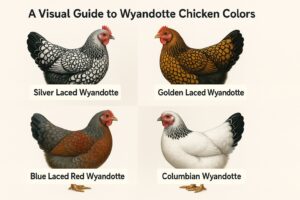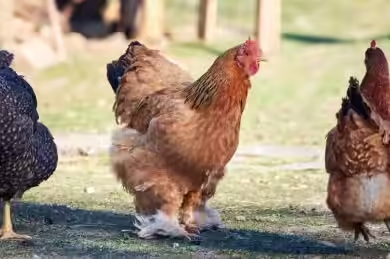Last updated on August 2, 2025
While the Wyandotte chicken is famous for its steady egg-laying and friendly nature, it’s the breed’s stunning beauty that often first captures a keeper’s attention. With a wide array of intricate patterns and striking solid colors, the Wyandotte chicken colors are as diverse as they are beautiful. This guide will provide a visual tour of the most popular and beautiful Wyandotte color varieties recognized by poultry associations and enthusiasts.
Quick Comparison: Wyandotte Chicken Colors Chart
| Variety | Primary Feature | Rarity / Popularity | Best For… |
|---|---|---|---|
| Silver Laced | Classic black & white pattern | Very Popular | The iconic, traditional look. |
| Gold Laced | Rich gold & black pattern | Very Popular | A warm, opulent flock aesthetic. |
| Blue Laced Red | Unique blue & red pattern | Rare / Sought-After | A modern, “showstopper” flock. |
| Columbian | Stark white & black points | Common | A clean, high-contrast look. |
| Black | Solid beetle-green sheen | Common | Understated, elegant beauty. |
| Blue / Lavender | Soft, solid pastel colors | Less Common | A unique, gentle-looking flock. |
Understanding Wyandotte Patterns: What is “Lacing”?
Many of the most popular laced Wyandotte chicken colors are defined by a specific pattern called “lacing.” A laced feather has a border of a different color around the main feather. This creates a crisp, clean-edged appearance that looks like the chicken’s feathers have been meticulously painted by hand. The quality of this lacing—its crispness and evenness—is what separates a good show bird from a great one.
The Classic Laced Varieties
The laced varieties are perhaps the most iconic and recognizable of all Wyandotte chickens.
Silver Laced Wyandotte
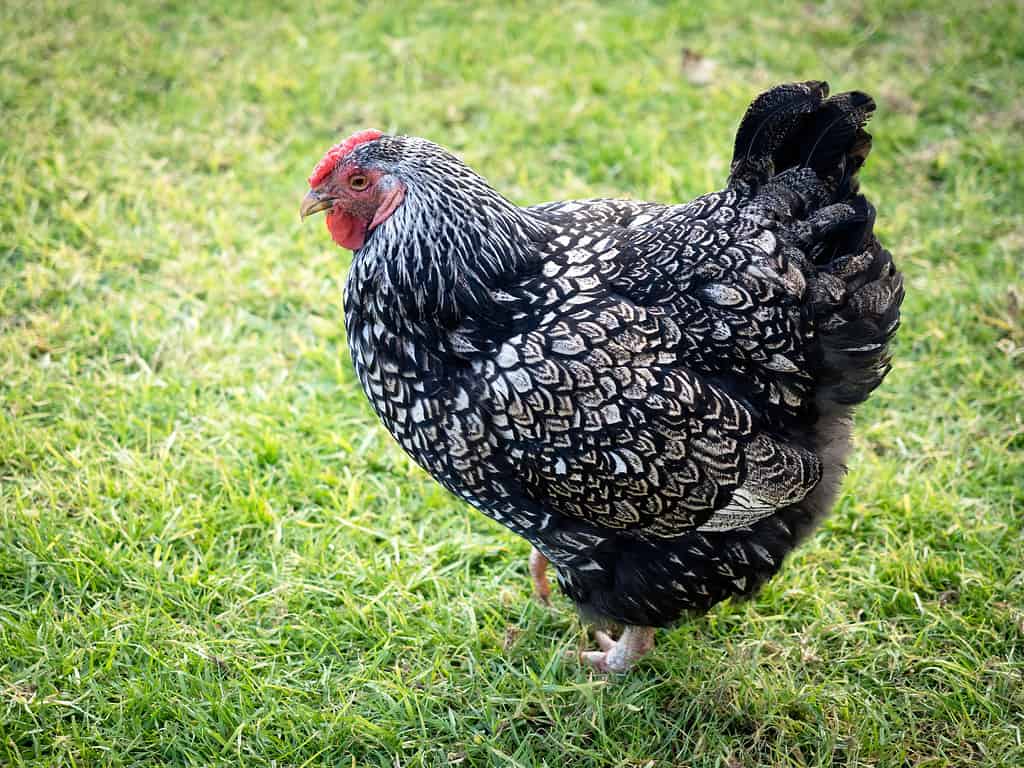
The Silver Laced Wyandotte is the original and most famous variety, setting the standard for the breed’s beauty. This hen features crisp, clean black lacing around brilliant silvery-white feathers, creating a sharp and stunning contrast.
Keeper’s Notes:
- What to Look For: In a high-quality bird, the lacing should be distinct and complete on the breast and back feathers. Avoid birds with “mossy” or incomplete patterns.
- Chick Appearance: Silver Laced Wyandotte chicks are typically dark gray or black with yellow patches on their face, belly, and wing tips. When raising them from this age, it’s vital to know how to prevent the most common causes of chick mortality.
- Fun Fact: This variety was the first Wyandotte to be accepted into the American Poultry Association’s Standard of Perfection in 1883.
Gold Laced Wyandotte
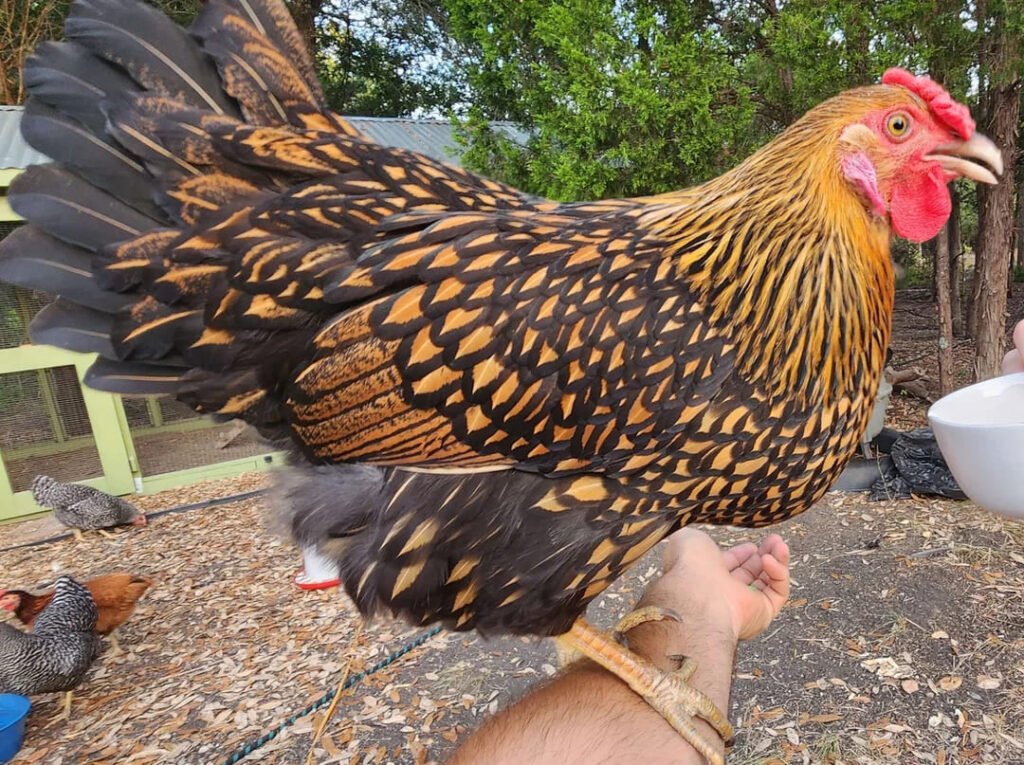
The Gold Laced Wyandotte is an equally stunning variety, with black lacing on a rich, golden-bay feather base. This rich combination of colors creates a warm, opulent appearance that stands out in any flock. The golden laced wyandotte chicken colors are a fan favorite for their warm aesthetic.
Keeper’s Notes:
- What to Look For: The golden-bay color should be a deep, uniform shade. The black lacing should be distinct and clean, especially on the back and breast.
- Chick Appearance: Gold Laced chicks are a striking caramel or rusty brown with darker stripes on their back.
- Fun Fact: The Gold Laced variety was developed shortly after the Silver Laced and quickly gained popularity, becoming one of the most beloved color patterns.
Blue Laced Red Wyandotte
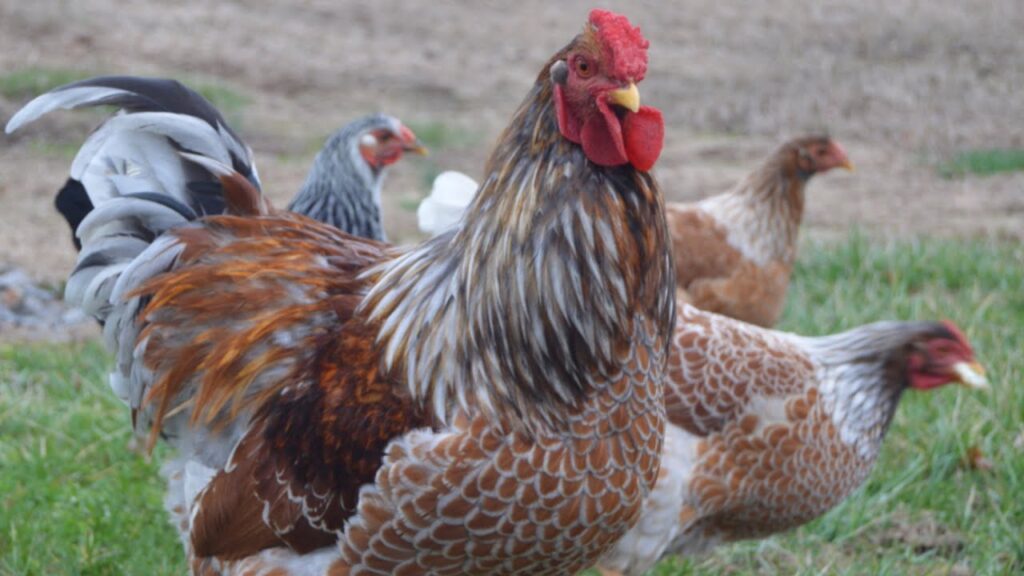
A true showstopper, the Blue Laced Red Wyandotte is one of the more recent and eye-catching varieties. It features beautiful blue-slate lacing on deep red or buff feathers. The blue color adds a soft, elegant touch to the classic laced pattern. The unique blue laced red wyandotte chicken colors make them a prized possession for many keepers.
Keeper’s Notes:
- What to Look For: The “blue” is actually a gene that creates a shade of slate-gray. Look for even lacing on a rich, buff or red base. The neck feathers are often a darker blue.
- Genetics Tip: The blue color gene doesn’t breed true. A clutch of eggs from two blue-laced parents will produce chicks that are Blue Laced, Black Laced, and “Splash” (a much lighter, splotchy pattern).
- Fun Fact: This is a relatively modern variety, created by crossing Gold Laced Wyandottes with blue chickens. Its unique color has made it one of the most sought-after varieties for backyard enthusiasts.
Other Striking Wyandotte Varieties
Beyond the classic laced patterns, Wyandottes come in a wide range of solid and patterned colors.
Columbian Wyandotte
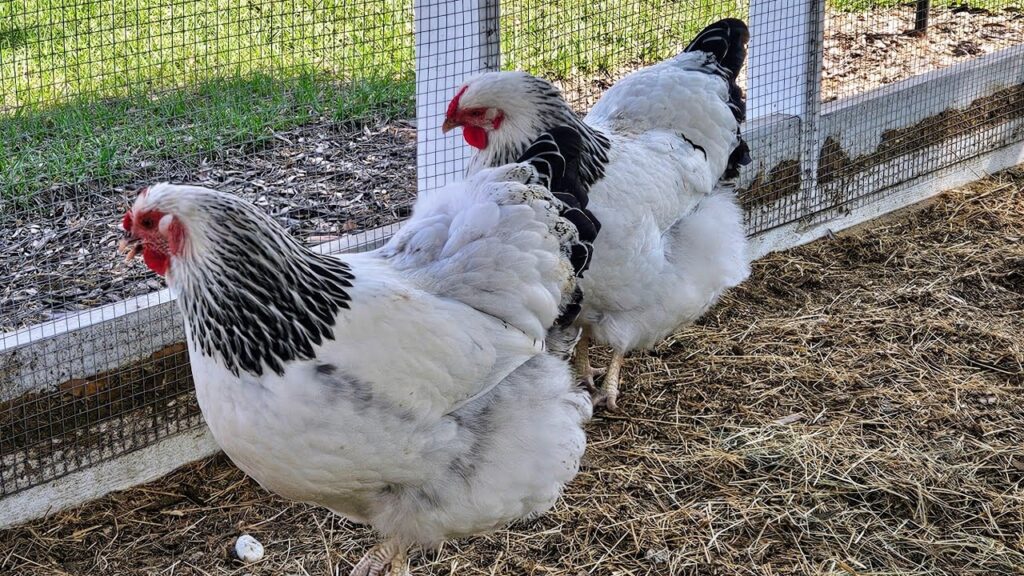
The Columbian Wyandotte has a stark, beautiful contrast. They have a mostly white body with black points on the neck, wings, and tail. This is a simple yet elegant look that makes them easy to spot in a crowd.
Keeper’s Notes:
- What to Look For: The body should be a clean, brilliant white. The hackle feathers (on the neck) and the tail feathers should be jet black, with no stray black feathers on the back.
- Free-Ranging Tip: Their bright white bodies make them more visible to both keepers and predators in a free-range setting. However, their light color also makes them more comfortable in hot, sunny climates.
- Fun Fact: The Columbian variety was named in honor of the 1893 Columbian Exposition in Chicago, where it was first introduced.
Black Wyandotte
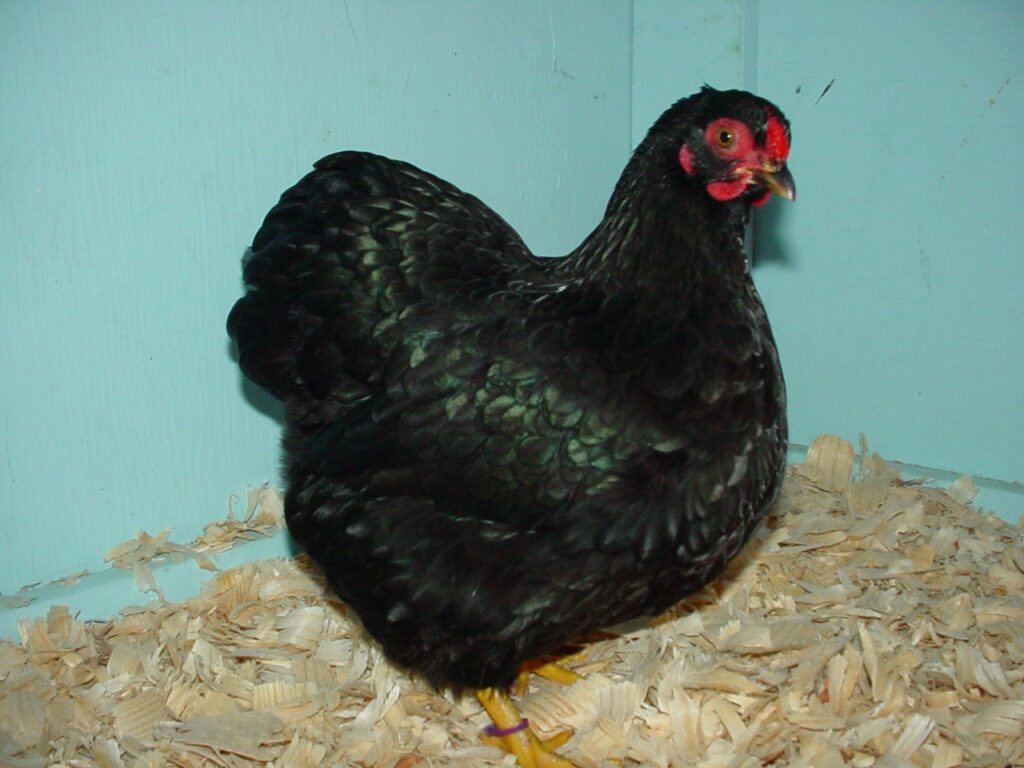
The solid Black Wyandotte may seem simple, but their beauty is in the details. When the light hits them just right, their feathers shimmer with a beautiful greenish-black sheen, giving them a glossy, sophisticated look.
Keeper’s Notes:
- What to Look For: The plumage should be an even, solid black. The most desirable birds have a bright beetle-green sheen on their feathers.
- Management Tip: Their dark plumage can make them harder to spot in low-light conditions, such as at dusk. Be sure to count your flock before locking them in for the night.
- Fun Fact: This variety is a great example of a simple color pattern with a lot of depth and is a favorite among those who appreciate the subtle beauty of a well-bred solid-colored bird.
Blue & Lavender Wyandottes
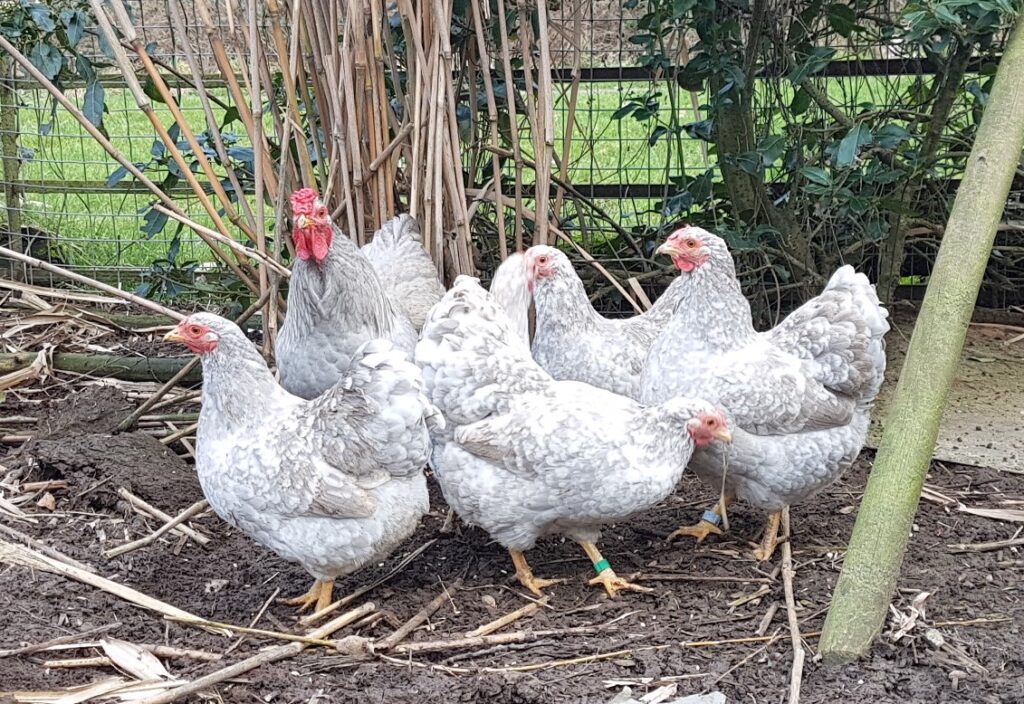
The solid-colored Blue Wyandottes and Lavender Wyandottes are appreciated for their soft, even shades of blue-gray or a light, dusty lavender. These two varieties are similar, with lavender being a lighter, more muted version of the blue. The lavender wyandotte chicken colors are particularly sought after for their unique, pastel appearance.
Keeper’s Notes:
- What to Look For: The color should be uniform across the body. Blue birds have a medium slate-gray, while lavender has a pale, pastel tone.
- Temperament Tip: These solid-colored varieties are prized for their calm demeanor and unique, elegant appearance. This gentle nature is a key part of raising happy, healthy chickens that thrive.
- Fun Fact: The lavender color is a rare recessive gene, making this variety particularly sought after by enthusiasts.
Do Colors Affect Temperament or Egg Production?
This is a common question, and the answer is no. The color of a Wyandotte chicken does not affect its temperament or egg-laying ability. Temperament and productivity are traits of the breed as a whole, not specific to a single color variety. All Wyandotte chickens, including the Silver Laced Wyandotte and Blue Laced Wyandottes, are known for being docile and reliable layers. Their ability to produce consistently makes them a top choice when considering how many eggs your chickens will lay over a year.
Regardless of their feather color, all Wyandottes are considered excellent dual-purpose chickens, valued for both meat and eggs. It’s important to remember that some strains bred specifically for exhibition may lay slightly less than utility strains, but this is a result of selective breeding and not related to the color itself.
Choosing the Right Wyandotte Variety for Your Flock
While all Wyandottes share a calm temperament and good laying ability, choosing a color often comes down to personal preference and your specific goals.
- For the Traditional Homesteader: If you love the classic, iconic look of a heritage flock, the Silver Laced and Gold Laced varieties are perfect choices. They are widely available and represent the breed’s history.
- For the Backyard Stylist: If you want a flock that turns heads and looks stunning on your lawn, the Blue Laced Red is an unmatched showstopper. Be prepared, as they are often more expensive and harder to find.
- For High-Contrast Visibility: If your chickens will be free-ranging over a large, dark area, the bright white body of the Columbian Wyandotte makes them incredibly easy to spot from a distance.
- For Showing and Exhibition: If you are interested in poultry shows, you are moving beyond a simple hobby and into the realm of serious poultry farming. It’s crucial to source your birds from a breeder who focuses on the APA’s Standard of Perfection. This level of dedication is a key part of any successful poultry farm business plan.
Frequently Asked Questions about Wyandotte Colors
What are the different colors of Wyandottes?
Wyandottes come in a wide range of colors and patterns, including classic laced varieties like Silver Laced and Gold Laced, solid colors like Black, Blue, and Lavender, and patterned varieties like Columbian and Blue Laced Red.
Which Wyandotte color is the best egg layer?
Egg production is a trait of the breed, not the color. However, strains bred for utility may lay more than those bred purely for exhibition.
What is the rarest Wyandotte color?
While many Wyandotte colors are less common than the Silver or Gold Laced varieties, the Blue Laced Red Wyandotte and Lavender Wyandotte chicken colors are generally considered among the rarest and most difficult to find from breeders.
Do Blue Laced Red Wyandottes lay blue eggs?
No. The “blue” refers to their feather color only. All Wyandottes lay cream to light brown eggs.
How can I tell what color my Wyandotte chick will be?
For most varieties, the chick’s down color gives a good indication. Silver Laced are dark with yellow spots, while Gold Laced are brown with darker stripes.
Conclusion
From the timeless Silver Laced Wyandotte to the exotic Blue Laced Wyandottes, this breed offers an incredible array of beauty and diversity. While their appearance is what first attracts many keepers, their reliable productivity is what makes them a flock favorite. To learn everything about their output, read our Ultimate Guide to Wyandotte Egg Laying.
